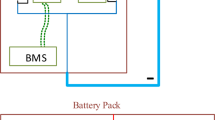Abstract
The increasing number of electronic control units (ECUs) inside a vehicle implies the need to develop and deploy on board robust, low latency and low complex telecommunication systems. In this respect, power line communications (PLC) is an attractive solution. The benefits provided by the introduction of power line communications in the in-car environment are multiple and they are related to the possibility of exploiting the existing and capillary wiring infrastructure to simplify the design of the in-vehicle data network (IVN) and, more importantly, to save weight and cost of the wiring harness. In this paper, we deal with the analysis of the performance achievable by applying innovative advanced modulation techniques to in-car measured power line channels, i.e., multicarrier (MC) and impulsive ultra wideband (I-UWB) modulation. We show that for low speed command and control applications, I-UWB is suitable since it requires lower power and lower computational efforts w.r.t. MC systems. Furthermore, we study the design of the optimal transmitted pulse to further improve the performance of I-UWB.
Similar content being viewed by others
References
Antoniali, M., Tonello, A. M., Lenardon, M. and Qualizza, A. (2011). Measurements and analysis of PLC channels in a cruise ship. Proc. IEEE Int. Symp. Power Line Commun. and Its Appl. (ISPLC), 102–107.
Cortés, J. A., Cerdá, M., Díez, L. and Cañete, F. J. (2012). Analysis of the periodic noise on in-vehicle broadband power line channels. Proc. IEEE Int. Symp. Power Line Commun. and Its Appl. (ISPLC), 334–339.
Degardin, V., Lienard, M., Degauque, P. and Laly, P. (2007). Performances of the homeplug PHY layer in the context of in-vehicle powerline communications. Proc. IEEE Int. Symp. Power Line Commun. and Its Appl. (ISPLC), 93–97.
Ferreira, H. C., Lampe, L., Newbury, J. and Swart, T. G. (2010). Power Line Communications — Theory and Applications for Narrowband and Broadband Communications Over Power Lines. Wiley and Sons. Hoboken. New Jersey.
Ferreira, A. L. S. and Ribeiro, M. V. (2010). A discussion about the suitability of UWB modulation for outdoor power line communication. Proc. IEEE Int. Symp. Power Line Commun. and Its Appl. (ISPLC), 102–107.
FCC-Fedral Communications Commission (2002). Code of Federal Regulations. Title 47, Part 15, Subpart F. Ultra-Wideband Operation.
Gouret, W., Nouvel, F. and El-Zein, G. (2007). Powerline communication on automotive network. Proc. IEEE Vehicular Technology Conf. (VTC), 2545–2549.
Huck, T., Schirmer, J. and Dostert, K. (2005). Tutorial about the implementation of a vehicular high speed communication system. Proc. IEEE Int. Symp. Power Line Commun. and Its Appl. (ISPLC), 162–166.
Kim, M., Lee, S. and Lee, K. (2012). Expanding transmission capacity of can systems using dual communication channels with kalman prediction. Int. J. Automotive Technology 13,2, 301–308.
Lampe, L. (2008). Data base of in-vehicle power line channel measurements. Available at: http://www.ece.ubc.ca/~lampe/VehiclePLC.html
Lee, S., Lee, D., Kim, M. and Lee, K. (2010). Trafficbalancing algorithm for can systems with dual communication channels to enhance the network capacity. Int. J. Automotive Technology 11,4, 525–531.
Lienard, M., Carrion, M., Degardin, V. and Degauque, V. (2008). Modeling and analysis of in-vehicle power line communication channels. IEEE Trans. Veh. Technol. 57,2, 670–679.
Mohammadi, M., Lampe, L., Lok, M., Mirabbasi, S., Mirvakili, M., Rosales, R. and van Veen, P. (2009). Measurement study and transmission for in-vehicle power line communication. Proc. IEEE Int. Symp. Power Line Commun. and Its Appl. (ISPLC), 73–78.
Tonello, A. M., Rinaldo, R. and Scarel, L. (2004). Detection algorithms for wide band impulse modulation based systems over power line channels. Proc. IEEE Int. Symp. Power Line Commun. and Its Appl. (ISPLC), 367–372.
Tonello, A. M. (2007). Wide band impulse modulation and receiver algorithms for multiuser power line communications. EURASIP J. Advances in Signal Processing, doi:10.1155/2007/96747.
Tonello, A. M. and Pecile, F. (2009). Efficient architectures for multiuser FMT systems and application to power line communications. IEEE Trans. Commun. 57,5, 1275–1279.
Tonello, A. M., D’Alessandro, S. and Lampe, L. (2010). CCyclic prefix design and allocation in bit-loaded OFDM over power line communication channels. IEEE Trans. Commun. 58,11, 3265–3276.
Vallejo-Mora, A. B., Sáchez-Martínez, J. J., Cañete, F. J., Cortés, J. A. and Díez, L. (2010). Characterization and evaluation of in-vehicle power line channels. Proc. IEEE Global Telecommun. Conf., 1–5.
Van Rensburg, P. A. J. and Ferreira, H. C. (2003). Automotive power-line communications: Favourable topology for future automotive electronic trends. Proc. IEEE Int. Symp. Power Line Commun. and Its Appl. (ISPLC), 103–108.
Win, M. Z. and Scholtz, R. A. (1998). Impulse radio: How it works. IEEE Communications Letters 2,2, 36–38.
Author information
Authors and Affiliations
Corresponding author
Rights and permissions
About this article
Cite this article
Antoniali, M., Girotto, M. & Tonello, A.M. In-car power line communications: Advanced transmission techniques. Int.J Automot. Technol. 14, 625–632 (2013). https://doi.org/10.1007/s12239-013-0067-2
Received:
Revised:
Accepted:
Published:
Issue Date:
DOI: https://doi.org/10.1007/s12239-013-0067-2




